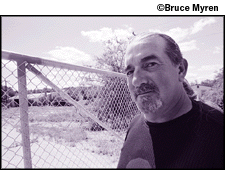August 24 - 31, 2000
![[Features]](/standard/image/headers/features_header.gif)
In practice, however, this created a new problem. Now the polluter doesn't just pay -- the polluter also hires the scientist to determine what needs to be done. That scientist draws up a clean-up plan, and that scientist -- in consultation with the polluter -- decides when enough is enough. Who's Watching the Fox, continued
by Lisa Birk
Critics said this was like putting the fox in charge of the hen house. Environmentalists said they wouldn't sign on unless the state created a watchdog. DEP agreed. To ensure that the interest of the polluter -- that is, saving money -- was checked by the state's interest in public health, sites would be subject to DEP auditing. The dirtiest and tardiest sites, called Tier IAs, would even get a DEP site manager with "direct oversight."
Seven years after privatization, clean-up is more efficient, and the DEP says the watchdog is doing a darn good job. During the four years before privatization, the department itself signed off on every aspect of clean-up for 225 sites. In the first four years after the switch, it oversaw the clean-up of 3146 sites to "close-out," meaning it determined that the site poses "no significant risk." Last year, DEP audited 22 percent of all sites, up from 4.2 percent in 1998. Enthusiasts call the Massachusetts DEP a national model. Connecticut adopted a version of privatization. And California is considering it.
But in Massachusetts, not everyone thinks it was such a good idea. Putting the fox in charge of the hen house created groups of concerned neighbors all over the state. And "the promise of privatization to dedicate more resources to the worst sites has not happened," says Matt Wilson, director of the Massachusetts branch of the Toxics Action Center. Sure, the gas stations get cleaned up. "But," says Wilson "the dirtiest sites are still lagging."
He thinks the reason is chronic underbudgeting. For example, he points to a minuscule clean-up budget of $5 million for fiscal year 2000 (FY00), one-fifth of which was targeted for a single Needham site. In 1992, DEP projected that clean-ups in 1997 would cost $25 million. A DEP spokesperson noted that DEP can and does apply for extra funds from the state government: in FY00 the department spent $19 million on clean-up, $14 million more than its original budget. Still, is it enough?
Rockland, classified Tier IA, is exactly the sort of site that was supposed to be targeted when privatization freed the state's resources for the worst cases. But for the past 13 years, seven of them since privatization, Rockland has been stuck in the second phase of the five-phase clean-up process that the state mandates for contaminated sites. (DEP's mandated total timeline for the first four phases is five years, although "complex sites" are allowed more time if any "imminent hazard" is eliminated.) Phase II is just assessment of the hazard -- clean-up doesn't come until Phase IV.
Sylvia and Enos are worried. Last November, groundwater sampling detected DCB at 18,000,000 ppb in one spot. In other words, pure DCB. Puddles of it. Trichlorobenzene (TCB) was found at 200,000,000 ppb. According to the Environmental Protection Agency (EPA), TCB harms the adrenal glands, which produce adrenaline and other hormones. If the contaminants are still so concentrated 19 years after the plant closed, how concentrated were they in 1980? And where did they go?
Chemicals leach into soil and water. What worries some scientists and neighbors is how far the chemicals may have traveled. There are at least seven private drinking wells near the site. None of those wells was tested from 1966, the year Rockland moved in, until this year -- after neighbors pressed DEP to push the Striar family, which owned Rockland and still owns the site. Eventually, DEP paid for the testing. The results came back last week. One well registered trichloroethylene (TCE), one of the very same chemicals DEQE found in 1980, at 13 ppb -- nearly three times the EPA's allowable standard. Drinking small amounts of TCE for long periods may cause liver and kidney damage, nervous-system effects, impaired immune-system function, and impaired fetal development, according to ATSDR.
DEP's southeast section chief, Gerard Martin, notes that testing private wells is not within DEP's purview, that the wells are more than 2500 feet away from the Rockland contamination, and that other pollutants commonly found at Rockland were not found in the wells. But some local residents believe contaminants may migrate from the site to the wells via Purchade Brook, which floods every spring.
Rockland is hardly the only site whose clean-up has fallen far behind schedule. Of 269 Tier IA sites, 121 had made "no progress" in four years, according to a 1998 DEP draft review. And 86 percent of Tier I sites had missed clean-up deadlines.
Lisa Birk can be reached at cellardr@aol.com.


